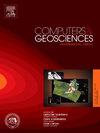Research on hyperspectral remote sensing alteration mineral mapping using an improved ViT model
IF 4.4
2区 地球科学
Q1 COMPUTER SCIENCE, INTERDISCIPLINARY APPLICATIONS
引用次数: 0
Abstract
The distribution of altered minerals is a key indicator for finding strategic minerals such as uranium, cobalt, nickel, copper and zinc. In recent years, deep learning has shown outstanding advantages in the field of hyperspectral altered mineral mapping. However, constructing a large volume of high-quality training samples remains time-consuming and labor-intensive. Moreover, many models suffer from limited generalization capability—performing well on training data but exhibiting significant performance degradation on test datasets or in real-world applications. Therefore, a semi-automatic sample construction method was proposed. The sample construction involves three steps. Firstly, using mixed pixel decomposition to extract mineral abundance, then screening samples via mixed matching, and finally enhancing classification accuracy with spectral characteristic quantification. Experimental results show that the test accuracy of the dataset generated by the semi-automated method on the ViT model reached 92.81 %, which is close to that of manually labeled samples at 93.29 %. In terms of models, an improved Vision Transformer (ViT) model was proposed. The SpecPool-Transformer model (SPT) integrates the Grouped Spectral Embedding Module (GSE) and the Convolution-Pooling Module (CPM) to enhance the extraction of adjacent band features from the spectral curves. Additionally, the model's application to cross-source data was achieved through transfer learning. On the SASI dataset of the Baiyanghe uranium deposit, the overall accuracy (OA) and average accuracy (AA) of SpecPool-Transformer reached 96.76 % and 95.14 %, respectively, representing improvements of 3.95 % and 6.11 % over the original ViT model. In the generalization test, the proposed method achieved an OA of 86.10 % and an AA of 83.74 % on the SASI aerial dataset No.1007, outperforming the second-best model, LightGBM, by 20.22 % and 31.15 %, respectively. Field validation results further confirm the high reliability of the proposed model in large-scale alteration mineral mapping across data sources, making it suitable for rapid and extensive alteration mineral mapping applications.
基于改进ViT模型的高光谱遥感蚀变矿物填图研究
蚀变矿物的分布是寻找诸如铀、钴、镍、铜和锌等战略矿物的关键指标。近年来,深度学习在高光谱蚀变矿物填图领域显示出突出的优势。然而,构建大量高质量的训练样本仍然是耗时和劳动密集型的。此外,许多模型的泛化能力有限——在训练数据上表现良好,但在测试数据集或实际应用中表现出明显的性能下降。为此,提出了一种半自动取样方法。示例构建包括三个步骤。首先利用混合像元分解提取矿物丰度,然后通过混合匹配筛选样品,最后利用光谱特征量化提高分类精度。实验结果表明,半自动化方法在ViT模型上生成的数据集的测试准确率达到92.81%,接近人工标记样本的93.29%。在模型方面,提出了一种改进的视觉变换器(ViT)模型。SpecPool-Transformer模型(SPT)集成了分组频谱嵌入模块(GSE)和卷积池化模块(CPM),增强了对光谱曲线邻带特征的提取。此外,通过迁移学习实现了模型对跨源数据的应用。在白洋河铀矿床SASI数据集上,SpecPool-Transformer模型的总体精度(OA)和平均精度(AA)分别达到96.76%和95.14%,比原ViT模型分别提高了3.95%和6.11%。在SASI航空数据集No.1007的泛化测试中,该方法的OA为86.10%,AA为83.74%,分别比第二优模型LightGBM高出20.22%和31.15%。现场验证结果进一步证实了该模型在跨数据源的大规模蚀变矿物填图中的高可靠性,适用于快速、广泛的蚀变矿物填图应用。
本文章由计算机程序翻译,如有差异,请以英文原文为准。
求助全文
约1分钟内获得全文
求助全文
来源期刊

Computers & Geosciences
地学-地球科学综合
CiteScore
9.30
自引率
6.80%
发文量
164
审稿时长
3.4 months
期刊介绍:
Computers & Geosciences publishes high impact, original research at the interface between Computer Sciences and Geosciences. Publications should apply modern computer science paradigms, whether computational or informatics-based, to address problems in the geosciences.
 求助内容:
求助内容: 应助结果提醒方式:
应助结果提醒方式:


